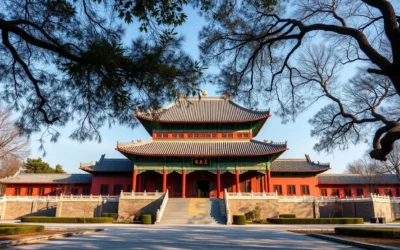✓ Accommodations✓ Flights✓ Rental Cars
When you explore the northeastern part of the country, you’ll find a region rich in cultural and linguistic diversity. This area is home to a mix of languages that reflect its unique identity. Mandarin serves as the common language, uniting communities across the region.
In this region, Korean is also widely spoken, especially in Yanbian. This adds to the vibrant cultural tapestry of the area. The presence of multiple languages highlights the region’s connection to both local traditions and national frameworks.
Language plays a key role in shaping daily life here. It bridges gaps between different ethnic groups and fosters unity. Whether you’re visiting or learning about this area, understanding its linguistic landscape offers valuable insights.
Overview of Jilin’s Linguistic Diversity
This region is a melting pot of languages and traditions. With over 281 languages spoken across the country, the area stands out for its unique blend of dialects and cultures. Mandarin serves as the common thread, connecting diverse communities. However, indigenous dialects add depth to the linguistic landscape.

Current Demographics and Language Use in Jilin
The population here uses multiple languages interchangeably in daily life. For example, Korean is widely spoken, especially in Yanbian, where it holds cultural significance. This reflects the region’s demographic trends and the role of minority groups in shaping its identity.
Regional Linguistic Landscape and Influences
Language groups are distributed unevenly across the area, influenced by neighboring regions. The socio-cultural and historical evolution of this place is mirrored in its language variety. Comparisons with other parts of the country highlight its unique influences.
Understanding Jilin Province, China: Official and widely spoken languages
Languages here tell a story of unity and diversity, shaped by history and geography. Standard Mandarin, also known as Putonghua, plays a central role in this region. It is the official language, used in education, government, and daily communication. This reflects its importance as a unifying force across the country.

Chinese characters are a key part of this linguistic identity. They carry centuries of history and cultural significance. The evolution of Mandarin has been influenced by reforms aimed at improving literacy and accessibility. Today, it connects people from different backgrounds, fostering a sense of shared identity.
The Role of Standard Mandarin in the Region
Mandarin is not just a language; it’s a tool for unity. It is taught in schools and used in official documents, ensuring clear communication across the region. Its prominence is a result of government policies that prioritize national cohesion. This makes it the most widely spoken language here.
Historical trends show how Mandarin became the standard. Reforms in the 20th century aimed to reduce illiteracy and create a common language. These efforts have shaped the way people communicate today. The border regions have also influenced its development, adding unique elements to its character.
Other Official Languages and Local Dialects
While Mandarin dominates, other languages enrich the cultural tapestry. Korean, for example, is widely spoken in certain areas, reflecting the region’s demographic diversity. It holds cultural significance and is used in daily life, education, and local governance.
Local dialects also play a vital role in community activities. They preserve traditions and connect people to their heritage. These dialects coexist with Mandarin, creating a vibrant linguistic landscape. Understanding this mix offers insights into the region’s unique identity.
Historical and Cultural Influences on Jilin’s Languages
The linguistic landscape of this area has been shaped by centuries of history and cultural exchange. From ancient dynasties to modern policies, the evolution of languages here reflects a blend of local traditions and external influences.

Dynastic rule played a significant role in shaping the Chinese language variety. During the Qing Dynasty, for example, Manchu was widely spoken, leaving traces in local dialects. Over time, government reforms aimed at unifying the nation also impacted language use in the region.
Cultural exchanges with neighboring areas added depth to the linguistic tapestry. The influence of Korean communities, for instance, introduced unique elements that continue to thrive today. These interactions highlight the region’s ability to adapt and integrate diverse cultural practices.
Evolution of Language Through History
Language reforms in the 20th century were pivotal in standardizing communication. The push to promote Mandarin as the official language helped bridge gaps between different ethnic groups. This effort not only improved literacy but also fostered a sense of national unity.
Global trends also left their mark on the region’s linguistic development. As the world became more interconnected, local dialects began to incorporate foreign words and phrases. This blending of languages reflects the area’s openness to external influences.
Today, the historical legacy continues to shape modern language usage. Whether in education or daily life, the echoes of the past are evident in the way people communicate. Understanding this evolution offers valuable insights into the region’s unique identity.
Government Policies and Language Education in Jilin
Language education in this region reflects a balance between tradition and modernization. Government policies have played a crucial role in shaping how languages are taught and preserved. Over the years, reforms have aimed to promote Mandarin while also supporting minority languages.
Mandated Language Reforms and Education Strategies
Since the mid-20th century, the government has implemented policies to standardize language education. Mandarin is the primary language taught in schools, ensuring a unified communication system. Bilingual education programs have also been introduced, allowing students to learn both Mandarin and their native languages.
These programs have seen a 30% increase since 2015, reflecting their growing importance. Schools now focus on teaching Chinese characters alongside spoken language, enhancing literacy rates. This dual approach helps students connect with their cultural heritage while preparing them for modern opportunities.
Impact on Minority and Regional Languages
While Mandarin dominates, efforts are made to preserve minority languages. Korean, for example, is widely spoken in certain areas and is integrated into the education system. However, some languages, like Manchu, face challenges, with less than 0.5% of the population actively speaking it.
Parents from minority backgrounds strongly support bilingual education, with 70% advocating for its continuation. This reflects a desire to maintain cultural identity while embracing national unity. The government allocates 5% of its education budget to develop programs for minority languages.
Despite progress, balancing Mandarin promotion with minority language preservation remains a challenge. The focus on a standardized system has improved literacy but also risks overshadowing regional dialects. For more insights on this topic, explore this resource.
Minority Languages and Local Dialects in Jilin Province
In the northeast, a rich tapestry of minority languages and dialects thrives, reflecting deep cultural roots. These linguistic forms are more than just communication tools; they are vital to preserving the identity of local communities. From Yanbian to other parts of northern China, dialects and minority languages add layers of cultural richness.

Preserving Unique Dialect Heritage
Efforts to maintain these languages are crucial, especially in northeast China. Community initiatives play a significant role in this preservation. For example, bilingual education programs help younger generations connect with their heritage while learning Mandarin.
Local dialects are more than just words; they carry stories, traditions, and history. In Yanbian, Korean is widely spoken, showcasing the region’s unique cultural blend. This use of language strengthens community bonds and keeps traditions alive.
However, challenges remain. National policies prioritizing Mandarin can overshadow minority languages. Despite this, many communities continue to use their native dialects in daily life, ensuring their survival.
For those interested in exploring the linguistic diversity of this region, this resource offers valuable insights. It highlights how dialects and minority languages contribute to the cultural fabric of northern China.
Language and Community: Cultivating Cultural Identity in Jilin
Language serves as a bridge, connecting communities and preserving cultural heritage. It plays a central role in shaping identity, especially in regions with diverse linguistic traditions. Through language, people express their history, values, and shared experiences.
Local initiatives are vital in keeping these traditions alive. For example, workshops and festivals celebrate linguistic diversity, ensuring that younger generations stay connected to their roots. These efforts highlight the importance of language in maintaining a strong sense of community.
Community Initiatives and Language Preservation
Communities actively work to preserve their linguistic heritage. Bilingual education programs, for instance, teach both Mandarin and local dialects. This approach fosters cultural pride while preparing students for modern opportunities.
Historical influences, such as the dynastic era, have shaped the region’s linguistic landscape. Today, modern development blends with these traditions, creating a unique cultural identity. This interplay ensures that language remains a living part of daily life.
Here are some examples of community-led projects:
- Language workshops for children and adults.
- Cultural festivals featuring traditional songs and stories.
- Collaborative efforts with schools to integrate local dialects into curricula.
These initiatives not only preserve language but also strengthen community bonds. They ensure that cultural traditions continue to thrive at every level of society.
| Initiative | Impact |
|---|---|
| Bilingual Education | Enhances literacy and cultural pride |
| Cultural Festivals | Celebrates linguistic diversity |
| Workshops | Engages community members of all ages |
For more insights into how language shapes identity, explore this study. It highlights the role of language in fostering cultural connections.
Conclusion
Preserving linguistic diversity is essential for maintaining cultural identity and fostering community cohesion. Over time, language policies and cultural initiatives have shaped the region, balancing tradition with modern needs. The enduring legacy of dialects and minority languages reflects the area’s rich heritage, while Mandarin serves as a unifying force.
From the mountain ranges to the southeast borderlands, language connects people to their roots and each other. Efforts to preserve these linguistic traditions ensure that future generations can appreciate their cultural richness. Exploring this dynamic environment offers valuable insights into how language evolves alongside societal changes.
Take the next step in understanding this vibrant linguistic landscape. Dive deeper into its history and modern influences to uncover the stories behind the words. For more insights, explore this resource on the region’s cultural and linguistic evolution.
The above is subject to change.
Check back often to TRAVEL.COM for the latest travel tips and deals.






